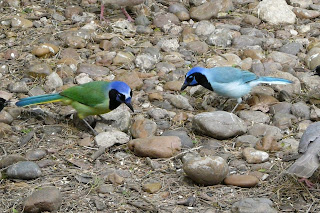It’s not every day
that a birder finds a statewide rarity on his home turf. But, it happened to me
during the first Cass County Christmas Bird Count on December 19, 2013. Here’s a short
story about how I found the bird.
 |
| Spotted Towhee by Eric Ripma |
Before the CBC I
had assigned myself a local trail that was in the circle called the River Bluff
Trail and some county roads. This spot usually isn't very good in winter but, I
was hoping for at least a Yellow-bellied Sapsucker to add to the count. So on count day I was at the trail bright and
early ready to find some birds. The birding started out pretty good, I got the
adult male sapsucker right off that I had hoped for. There were a lot of White-throated and
American Tree Sparrows out along the trail and meadows. Right along the trail, where a river runs
parallel, I scored an American Black Duck with a flock of Mallards, which I
usually don’t see on that section of the river. Since the trail is 5 miles round-trip
and there was 6 inches of snow on the trail the ground, walking was tough going
but, I didn't mind. Once I had birded the entire trail, I headed back through the
trail again since it is one way. As I was walking, I noticed two female Eastern
Towhees sitting in a bush. I was pretty excited about adding them to the count
since that species is hard to get in the winter this far north. After I had
looked at them, I noticed an adult male towhee nearby that had white spots on
his back. I thought to myself that it looked
good for Spotted Towhee - which is a western towhee that occurs in Indiana only
on rare occasions. I studied the bird
for a little while before it flew off. Pretty sure that I was correct on my ID,
I ran down the trail to my car (which was half a mile away) to check a guide
and sure enough the guide confirmed that I had just seen a Spotted Towhee in Indiana!!! I was pretty excited but, because I knew I
needed to finish birding the rest of my area, I left the trail to bird more and
then get the word out at lunch.
During
the CBC lunch I was able to get the word out and after lunch some of the
birders came with me to re-find the towhee and to document my finding. Luckily we were able to find it within a few
minutes and we were able to get some decent shots of it. The bird stayed for a
few more days before it moved on, allowing more birders from around the state
to come and see it. Hopefully next year’s Cass County CBC will be as memorable
as this one.






















